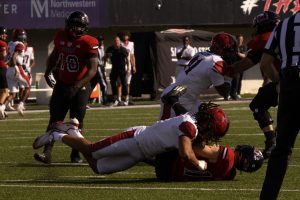Feeney, Stevens selected in MLB draft
June 17, 2008
Bobby Stevens’ cell phone woke him up on the morning of Friday, June 6. However, this wasn’t an ordinary Friday morning, and the phone call wasn’t from one of his friends.
The call was from a scout from the Baltimore Orioles, who told Stevens, who had just finished up his third season as a shortstop at NIU, to be prepared to be selected by Baltimore in the next couple of rounds of the 2008 MLB draft.
“I didn’t know what time (the draft) was supposed to start,” Stevens said. “Then I finally logged on the Internet and it was already the middle of the 10th round. The scout said he was going to try and snag me the next couple of rounds.”
A couple of rounds passed, and Stevens still didn’t see his name appear on MLB.com’s draft tracker. A few more rounds, still nothing.
Finally, Stevens got another call from the scout, asking him if he would sign.
Stevens said he would most likely sign, and Baltimore selected him in the sixteenth round with the No. 476 pick in the draft.
“My whole family was there, it was pretty exciting,” Stevens said.
The highest Huskie drafted since 2003, Stevens has already signed with the Orioles and reported to the team’s spring training complex in Fort Lauderdale, Fla.
He will train there for a few days and then find out where he will head for short season ball.
After players get drafted, they usually head to rookie ball for their pro debut. Rookie ball is the lowest level of minor league baseball and starts at the end of June.
Stevens will head to either head to the Orioles rookie ball club in Bluefield, W. Va., or their short season A ball affiliate in Aberdeen, Md.
Short season A ball is a more advanced version of rookie ball, where the teams are filled mostly with college players.
Stevens played shortstop at NIU, but could find himself at a different position in professional ball.
The Orioles said Stevens will play either middle infield or catcher. Stevens doesn’t have any experience behind the plate, but the Orioles like his athleticism and think he will be able to handle it.
Moving athletic players behind the plate is a trend that more teams have been taking advantage of recently.
Los Angeles Dodgers All-Star catcher Russell Martin was drafted as a third baseman. Florida State catcher Buster Posey, the No. 5 overall pick in the draft, started his college career as a shortstop.
Catcher is the premium position in baseball, and good hitting catchers are extremely valuable.
“I was kind of shocked but excited,” said Stevens when the Orioles told him he might be catching. “Good defensive catchers make it to the big leagues and hitting is just a bonus. I only think it helps me.”
At the beginning of the season, Stevens wouldn’t have been looked at as a high draft pick.
The Chicago native had a .252 average his first two seasons, but he was able to turn it around his junior year.
Stevens hit .308 on the season while drawing 16 walks and setting a school record by being hit by a pitch 27 times. He finished third in the MAC with 20 stolen bases, while adding 20 doubles and a team-high three triples.
“I just didn’t care (about getting drafted) as much,” Stevens said. “My first two years I was so focused on getting drafted. I think I just kind of let loose.”
“It was really gonna be a matter of his offensive production, improving from what he did last year,” said NIU head baseball coach Ed Mathey, who has had eight players drafted during his tenure, which began in 2003. “When that started to click you could see a little more interest from the scouts.”
Stevens wasn’t the only Huskie drafted this past week. Pitcher Trevor Feeney was selected by the Detroit Tigers in the 31st round. It was the second time Feeney has been drafted in as many years.
“It’s an honor to get picked up by the Detroit Tigers,” Feeney said. “I am excited to get ready to start my pro career with the Tigers’ organization and continue on playing the game I have grown up loving to play.”
The Channahon, Ill., native was taken by the Kansas City Royals in the 39th round of last year’s draft, but opted to return to NIU for his senior season, which paid off with Feeney being selected eight rounds higher.
“To move up eight rounds as a senior as a good thing,” said Mathey, referring to the fact that teams will sometimes pass on seniors knowing there is a possibility they can sign them as undrafted free agents. “For him to get drafted that’s a good indication that he improved. He was our cornerstone all year on the mound.”
Feeney finished the season with a 6-4 record and 4.82 ERA with a team-high 93.1 innings and ranked second in the MAC with two complete games.
Feeney has been at the Tigers’ spring training complex in Lakeland, Fla., where he will receive his assignment.
Feeney will most likely end up at the Tigers’ short season A affiliate in Oneonta, N.Y., or their rookie Gulf Coast league affiliate, which plays at the Tigers’ spring training complex in Lakeland.
Stevens and Feeney weren’t the only players with NIU ties to get drafted. Fox Lake native Kyle Stroup was the last pick in the draft by the Boston Red Sox, and he has committed to play at NIU.
However, Stroup has informed Mathey that he won’t be headed to DeKalb.
If he doesn’t sign with Boston, Stroup will head to Chipola Junior College in Florida, where he will be eligible to get drafted next year.
If players attend a four-year school, they aren’t eligible to get drafted until their junior year or when they turn 21. Players who attend junior college are eligible after their first year.






